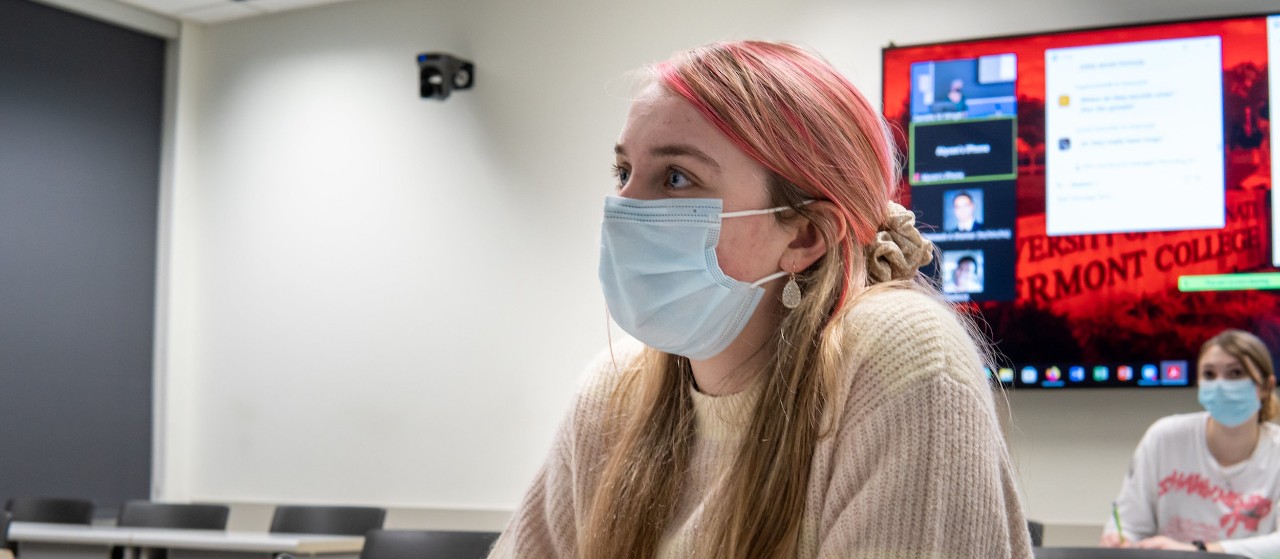
On campus one day, online the next: HyFlex classrooms in high demand at UC Clermont
Hybrid-flexible format gives students more control, options
Leading biology students through a dissection always results in lots of questions, said UC Clermont Assistant Professor Danielle Winget. Spring semester was no exception — but this time, Winget fielded queries from both inside the lab and via Zoom, asked by students watching live through a high-definition hover camera stationed directly above the action.
“Assessments are built around what happens in class, so students need access to class-specific material, not generic information,” Winget said. “In lab, cameras can display specimens and work so that online students can see what we’re doing and ask questions live. It brings them into the experience, no matter where they might be.”
While the COVID-19 pandemic took online learning to a new level, UC Clermont now offers students the next iteration: the ability to choose to attend class in person or online on any given day — combined with the technology to feel like they are in the classroom in real time, from anywhere.
It’s all possible thanks to the new HyFlex, or hybrid flexible, course format. The technology utilizes multiple camera angles, ceiling microphone arrays and large monitors that allow an instructor to “see” and teach online students alongside in-person pupils. The microphones track whoever is speaking, and lectures can be recorded.
It’s all designed to make remote students feel like they are in the classroom.
Mel Sweet Director of Information Technology, UC Clermont
And while HyFlex is a growing trend in higher education, Mel Sweet, director of information technology, said UC Clermont’s video and audio quality set the college apart.
“It’s all designed to make remote students feel like they are in the classroom,” Sweet said.
Professor Karen Lankisch, director of UC Clermont’s Center for Teaching, Learning and Innovation, said HyFlex grew out of the pandemic-created desire for flexible options to meet student needs.
“When we were thinking about returning to campus, we knew that with this technology we could better serve students,” Lankisch said “Even when we were fully remote, we had faculty come to campus and teach in their classrooms. It provided us with a lot of leeway in how we were going to transition back to campus.”
For pre-health science student Lauren Carl, the HyFlex option has been a perfect fit. Though Carl enrolled as an online student in Winget’s biology course, she has attended most classes this semester in-person.
“I have a genetic condition and frequent doctor appointments that sometimes require me to miss class,” Carl said. “The HyFlex experience allows me to attend class virtually or watch the recordings of lectures that I cannot attend so that I can pursue my degree while also maintaining my health. I definitely foresee myself taking more HyFlex classes in the future.”
Visiting Assistant Professor Emily Westbrook, who teaches organic chemistry in the HyFlex format, said Carl’s situation is an example of how the option “reflects real life.”
“As students get more familiar with HyFlex, it’s going to become the primary or typical setup,” Westbrook said. “Attending class solely in person or online only will be the secondary option. In trying to balance life, work, etc. — HyFlex enables students to have the flexibility they need to be successful.”
The funding for the three UC Clermont classrooms currently outfitted for HyFlex came from grants. In the pilot spring semester, five faculty members have used the technology in at least 10 courses. The option has been so effective that UC Clermont plans to invest in a dozen more HyFlex classrooms in the near future, particularly as the technology fits well within the college’s longstanding mission of making higher education accessible and affordable, said Lankisch. Several other UC colleges are looking to recreate the Clermont model in their classrooms, too.
“There is a [HyFlex] trend, but you have to do it right. You have to design it well,” Lankisch said. “Consistency, ease of use and having faculty use different styles of teaching to engage remote learners are all important. The pandemic has made flexibility the name of the game. HyFlex gives students even more options to personalize their educational experience.”
In world where hybrid and flexible arrangements are quickly becoming the norm, Winget said, colleges like UC Clermont have an opportunity to provide a training ground for students while serving as a springboard for ideas.
“As a community, it gives us a chance to practice how these HyFlex setups function,” Winget said. “Workers want to work from home. College is good practice space for that technology. Let’s create the workspaces we want in the future here, now.”
Feature photo: Morgan Gelter, UC Clermont student government president, takes notes in Assistant Professor Danielle Winget’s Biology II class. The course is offered in the HyFlex format, allowing students to choose to attend online or in person on any given day. Photo/Danny Kidd, UC Clermont
Related Stories
NEXT Innovation Scholar Charlie Harker
April 21, 2025
From strategizing with community leaders on the future of transportation solutions to collaborating with global corporate partners to dive into complex consumer insights, the NEXT Innovation Scholars (NIS) program at the University of Cincinnati empowers a new generation of leaders and problem solvers.
UC study examining overdose hot spots
April 21, 2025
WCPO covered a research collaboration between the University of Cincinnati and the Hamilton County Office of Addiction Response that takes a new approach to help combat the growing overdose crisis in the region.
UC celebrates Earth Day with greener, bolder moves
April 18, 2025
This year, UC’s Earth Day celebration honors a growing portfolio of eco-conscious achievements that stretch across the main and regional campuses. In a university-wide effort that bridges environmental science, design and community action, Bearcats are proving that green isn’t just a color — it’s a culture.
